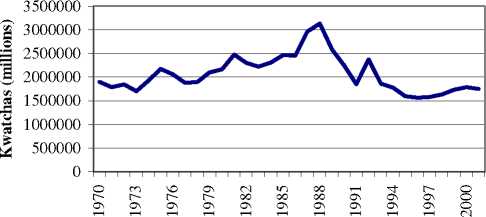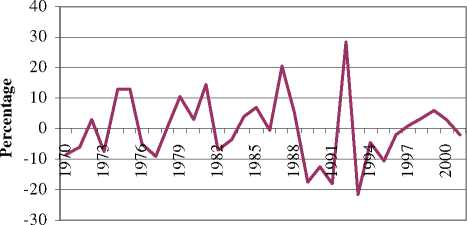K. Ludi: consumption behaviour in Zambia
and the comparison of consumption behaviour to poverty levels are done in section 5. A
conclusion with policy implications in section 6 completes this paper.
2. Background of Zambian Private Consumption Expenditure
Zambia has overall shown a level trend in real private consumption expenditure (PCE)
since 1970. As can be seen from figure 1, there was slight growth in real PCE in the
1970s, which was followed by a peak in the late-1980s. A sharp decline in real PCE in
the early-1990s followed, from which the economy has not recovered.
Figure 1: Real PCE in Zambia in constant Zambian Kwatchas (millions) (1970 - 2001)

Figure 2 indicates that the increased growth in real PCE in Zambia in the late-1990s
contributed to the positive real GDP growth rates of that period. However, the alarming
trend is one of decreasing and negative growth rates in the early-2000s.
Figure 2: Annual growth rates of real PCE in Zambia (1970 - 2001)

More intriguing information
1. Human Development and Regional Disparities in Iran:A Policy Model2. The name is absent
3. ENERGY-RELATED INPUT DEMAND BY CROP PRODUCERS
4. Geography, Health, and Demo-Economic Development
5. Road pricing and (re)location decisions households
6. Deletion of a mycobacterial gene encoding a reductase leads to an altered cell wall containing β-oxo-mycolic acid analogues, and the accumulation of long-chain ketones related to mycolic acids
7. Education and Development: The Issues and the Evidence
8. The name is absent
9. Linkages between research, scholarship and teaching in universities in China
10. The name is absent